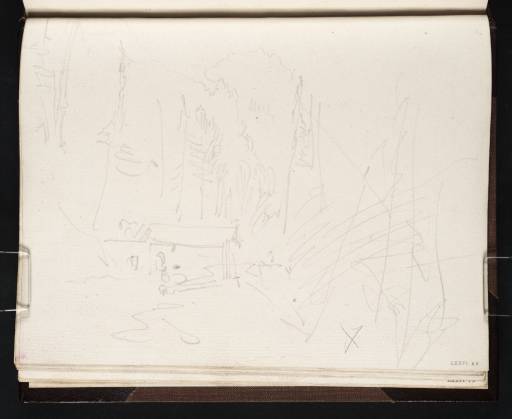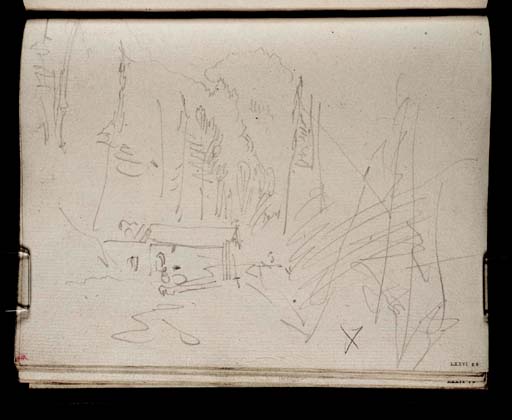Joseph Mallord William Turner The St Gotthard Road between Amsteg and Wassen 1802
Image 1 of 2
Joseph Mallord William Turner,
The St Gotthard Road between Amsteg and Wassen
1802
Joseph Mallord William Turner 1775–1851
Folio 66 Recto:
The St Gotthard Road between Amsteg and Wassen 1802
D04726
Turner Bequest LXXVI 66
Turner Bequest LXXVI 66
Pencil on white laid paper, 156 x 201 mm
Inscribed possibly by Turner in pencil with a cross or ‘F’ lower right of centre
Stamped in black ‘LXXVI 66’ bottom right
Inscribed possibly by Turner in pencil with a cross or ‘F’ lower right of centre
Stamped in black ‘LXXVI 66’ bottom right
Accepted by the nation as part of the Turner Bequest 1856
References
1909
A.J. Finberg, A Complete Inventory of the Drawings of the Turner Bequest, London 1909, vol.I, pp.206, LXXVI 66, as ‘Road, with hill-side, with snow-capped mountain in distance’, 212, with note to Tate D04897; Turner Bequest LXXX D.
1974
Martin Butlin, Andrew Wilton and John Gage, Turner 1775–1851, exhibition catalogue, Royal Academy, London 1974, p.47 under cat. no.66.
1976
John Russell and Andrew Wilton, Turner in Switzerland, Zurich 1976, p.134 as ‘Grt. St Bernard’.
1979
Andrew Wilton, The Life and Work of J.M.W. Turner, Fribourg 1979, p.341.
1992
David Hill, Turner in the Alps. The Journey through France and Switzerland in 1802, London 1992, p.135.
1993
Ian Warrell, J.M.W. Turner 1775–1851: Impressions de Gran Bretanya e el Continent Europeu / Impresiones de Gran Bretaña y el Continente Europeo, exhibition catalogue, Centro Cultural de la Fundació “la Caixa”, Barcelona 1993, p.288 under cat. no.21.
1994
Ian Warrell, J.M.W. Turner 1775–1851. Aquarelles et dessins du Legs Turner: Collection de la Tate Gallery, Londres /Watercolours and Drawings from the Turner Bequest: Collection of the Tate Gallery, London, exhibition catalogue, Palais des beaux-Arts de Charleroi, Charleroi 1994, p.90 under cat. no.21.
For the St Gotthard route, see especially folio 30 of this sketchbook (D04686). As Finberg was the first to observe, this sketch was worked up into a large colour study (Tate D04897; Turner Bequest LXXX D). The St Gotthard subject is confirmed by David Hill’s identification of the colour study, earlier suggestions having been the Great St Bernard Pass or the Jungfrau from the Lauterbrunnen road (both proposed by Finberg, who while noticing the connection with the pencil sketch did not give it a specific title). Previously, John Russell and Andrew Wilton had already suggested that the colour study might show the St Gotthard route, below Göschenen, in the Reuss valley, looking towards Wassen. They, and subsequently Wilton independently thought the coloured version was an unfinished watercolour, perhaps planned as a pendant to a large watercolour acquired by Walter Fawkes (Yale Center for British Art, New Haven, Connecticut).1
The mark on the pencil sketch, usually identified as a cross, has been taken to indicate Turner’s choice of the subject for further development; it may actually be the initial ‘F’, indicating Fawkes. This writer, however, has suggested a prospective alternative pairing, with the Battle of Fort Rock, Val d’Aouste, Piedmont, 1796, exhibited in 1815 but unsold (Tate D04900; Turner Bequest LXXX G). Since the colour study appears to show pilgrims, this would contrast the return of the Alpine routes to their peacetime functions with their recent role in war.2 In the event, Turner based his companion work for the 1815 exhibition on a view of Lake Lucerne on folio 41 of this sketchbook (Tate D04698).
Wilton 1979, p.341 no.365 as ‘Glacier and source of the Arveron, going up to the Mer de Glace’ exhibited at the Royal Academy in 1803. More recently Eric Shanes has argued that the Yale watercolour should be redated circa 1814 and associated with another title recorded in Fawkes’s collection, Mer de Glace, in the Valley of Chamouni, Switzerland; ‘Identifying Turner’s Chamonix water-colours’, The Burlington Magazine, vol.142, no.1172, November 2000, pp.693–4. Shanes’s case is persuasive on technical and stylistic grounds but for a cautious response see Gillian Forrester in John Baskett, Jules David Prown, Duncan Robinson and others, Paul Mellon’s Legacy: A Passion for British Art: Masterpieces from the Yale Center for British Art, exhibition catalogue, Yale Center for British Art, New Haven 2007, p.283.
Verso:
Blank
David Blayney Brown
February 2012
How to cite
David Blayney Brown, ‘The St Gotthard Road between Amsteg and Wassen 1802 by Joseph Mallord William Turner’, catalogue entry, February 2012, in David Blayney Brown (ed.), J.M.W. Turner: Sketchbooks, Drawings and Watercolours, Tate Research Publication, December 2012, https://www


